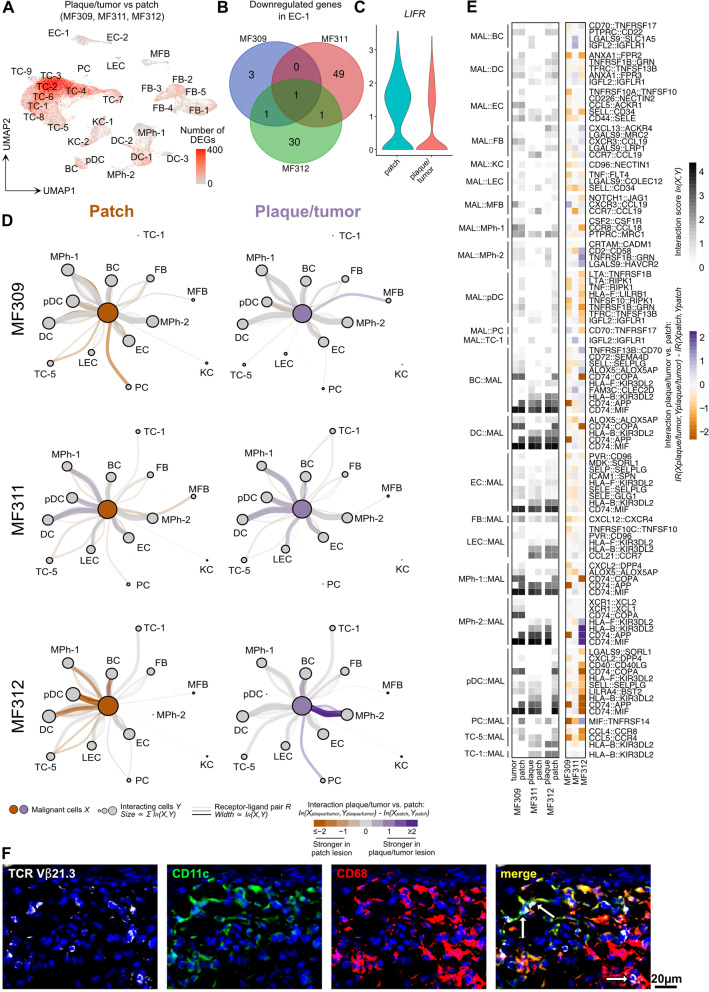Fig. 4.
Lack of consistent gene regulation or receptor/ligand interaction in cells of the microenvironment across patients. A Total numbers of differentially expressed genes (DEGs) within each cluster comparing palpable (plaque/tumor) with patch lesions in pooled samples, projected onto the UMAP plot. Differential gene expression was defined as log fold change >∣0.25∣ and adjusted p < 0.05 as calculated by logistic regression and Bonferroni correction. B Venn diagram of significantly downregulated genes comparing the gene expression between plaque/tumor and patch lesions in the endothelial cell cluster 1 EC-1 (adjusted p value< 0.05, logFCH>|0.25|). C Violin plots of LIFR expression in cluster EC-1 showing the distribution of normalized gene expression levels in pooled cells of patch (turquoise) and plaque/tumor (red) lesions. D Graph visualization of putative cell-cell interactions. Interactions were inferred by co-expression of ligand-receptor pairs (R) from CellPhoneDB [28] between malignant T cells (X) and each cell cluster (Y) in the same sample. Edge width is proportional to the interaction score (IR(X,Y)), which reports the mean expression of the receptor and ligand in the respective cell clusters. Node size is proportional to the sum of all connected interaction scores. Edge color indicates the difference of interaction scores between patch and plaque/tumor lesions of the same patient. Only receptor-ligand pairs with a significant interaction score in at least one sample are shown (FDR-adjusted empirical p-value <= 0.05, see Methods). E Heat map visualization of cell-cell interaction scores for each indicated receptor-ligand and cell type pair in each sample (left) or the difference between interaction scores in plaque/tumor and patch lesions (right). Interaction scores (IR(X,Y)) were inferred by co-expression of ligand-receptor pairs (R) from CellPhoneDB [28] between malignant T cells (X) and each cell cluster (Y) in the same sample. Only receptor-ligand pairs with a significant interaction score in at least one sample are shown (FDR-adjusted empirical p-value <= 0.05, see Methods). Dendritic cells DC-1, DC-2, DC-3, keratinocytes KC-1 and KC-2, fibroblasts FB-1 to FB-5, and malignant T cell clusters were pooled for analyses. F Representative immunofluorescence stainings of lesional MF skin (plaque) using a clone-specific anti-TCRVβ21.3 antibody to visualize cells of the expanded malignant clone, to demonstrate their vicinity (white arrows) to CD11c + CD68+ DCs and CD11c- CD68+ macrophages; DAPI-stained cell nuclei appear blue. Pictures are representative of three independent experiments. TC T cells; BC B cells; KC keratinocytes; FB fibroblasts; DC dendritic cells; MPh macrophages; MFB myofibroblasts; EC endothelial cells; LEC lymphoendothelial cells; pDC plasmacytoid dendritic cells; PC plasma cells

